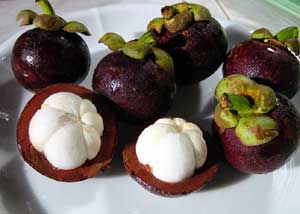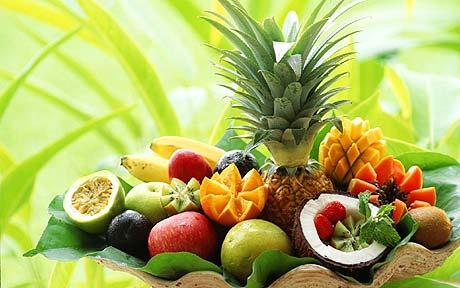Tropical
Tropical
Tropical

TROPICAL FRUITS.
THE goodness of God is seen in the abundance of fine fruits, which are found in the tropical, or warm, regions of the world. Most abundant of all is the banana, a splendid fruit, which we need not describe, as most of our readers have not only seen but also eaten it. Resembling the banana tree, is the plantain, which bears fruit of a similar kind, of a cucumber form, and which is alike pleasant to the taste and nourishing to the body.
Then there is the golden-fruited mango, accounted one of the most delicious of fruits. The tree is large, and the fruit is about the size of a goose's egg; it emits a fragrant odor, and melts in the mouth with a cooling sweetness. In India, the fruit is considered so precious that guards are placed over it as it approaches perfection. Another delightful fruit is the mangostan, a native of Sumatra and the Spice Islands. The fruit is of the size and shape of an orange, and of the flavor of the strawberry, pineapple, and grape combined.
The pawpaw tree, as seen at the right of our picture, is a native of South America. It is said that its growth is so rapid' that a seed, when planted, will produce in three years a tree whose trunk is twenty feet high, with its upper part laden with ripe fruit. It is for the sake of this fruit that the tree is cultivated. If gathered before it is ripe, it is soaked in water, boiled, and then eaten as turnips, or baked as apples. The juice of the ripe pulp is a powerful medicine; and the natives employ the leaves instead of soap in washing their linen.
An Oriental fruit of renown is the durion, reckoned next to the mangostan, or even superior to it, for richness of flavor, although it is not of so agreeable an odor. It is so highly esteemed in the Eastern Archipelago that one durion is worth more than a dozen choice pineapples.
Then there is the West Indian guava, with its yellow, egg-shaped fruit, of a very agreeable taste in its raw state, and also as a jelly; also, the cream fruit, a native of Western Africa, esteemed for its delicious qualities.
Better known to us is the tamarind. The pulp in which the seeds are inclosed is of a sharp taste, but it is a cooling article of food, possessing medicinal properties. The tree, adorned with feathery, pale green foliage, and prettily streaked flowers, presents a handsome appearance.
Lastly, we turn to the forbidden fruit, which is commonly classed in the same family as the orange and lemon. Its name is derived from a legend that it is the tree, which grew in Paradise. Indeed, the Mohammedans assign the site of the garden of Eden to the island of Ceylon, where this tree is extensively found. They say that the fruit may be known by the fragrance of its flower and the tempting beauty of its color. It presents the singular appearance of having had a piece bitten out of it, leaving, they say, the marks of the teeth of Eve; and as it now possesses a poisonous quality, it is said that this change from a delicious fruit passed over it as a judgment for the disobedience of our first parents.
Certain it is that the tree is held in high veneration by the Cingalese, though its curious fruit is avoided alike for its bad taste and the superstitious feelings associated with it. But, however singular and unfounded the Eastern story, the solemn fact in our world's history remains: "When the woman saw that the tree "in the midst of the garden" was good for food, and that it was pleasant to the eyes, and a tree to be desired to make one wise, she took of the fruit thereof, and did eat, and gave also unto her husband with her; and he did eat." Thus Eve was betrayed into the snare by her great desire to have her senses gratified.
She saw; she took; and she did eat; and then became a tempter to her husband. And thus sorrow and sin entered into the world, and death by sin; and so death passed upon all men.
But it is our happiness that, as we know of man's fall in Adam, we know of his salvation through the Son of God.

THE PINEAPPLE.
THE pineapple plant, of which we here have a picture, is highly esteemed, and much cultivated for its fruit. It has a number of long, sharp-pointed, rigid leaves, looking much like those of the century plant. These all spring from the root, and from the midst a short flower-stem is thrown up, bearing a single spike of flowers and therefore a single fruit. From the top of the fruit springs a crown, or tuft, of small leaves, capable of becoming a new plant, and very generally used by gardeners for planting. The pineapple is a native of South America, where it grows wild in the woods; and from there it has been carried to Africa and the East Indies, where it has become almost like a native plant, and scarcely requires cultivation. It is also raised to some extent in Great Britain and other temperate countries, but always in hot-houses, as it requires a high degree of temperature and very careful treatment. The fruit so grown, however, is said to be even superior in delicacy of flavor to that raised in the open air in its native countries.
